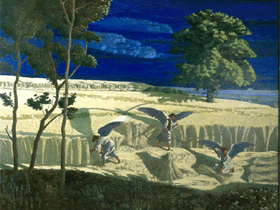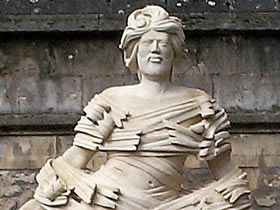01 July 2008
Bridging Church and Culture
The Alliance's Forum for Change initiative is examining Christian involvement in various spheres of society. Hazel Southam takes a look at how believers are making an impact through the arts…
A vocation is something that we associate with the clergy: monks, nuns and missionaries. It's not what we associate with sculptors, artists, actors and stand-up comedians.
This, according to Luke Walton, chair of the Forum for Change arts group, is where the evangelical Church has been going wrong in its understanding both of God's calling and of the arts. He hopes that the group can change this long-held misconception.
Evangelicals traditionally had "a fear of the arts", he says, because they can't control its outcome: two people will look at the same piece and respond differently. It isn't obviously evangelistic and if it is, then there's still no predicting the onlookers' reactions. This, coupled with a mistrust of iconography, has led some evangelical Christians to view the arts with suspicion.
"I hope our group will encourage evangelical leaders to explore the arts as a way of engaging with and learning how to read the culture, and therefore understanding the important messages the Gospel has for our age," he says.
Walton believes that the arts can form a bridge between the Church and Christianity and the rest of society and modern-day culture. Our daily lives are crammed full of the arts, whether we're watching TV, a film, going to the theatre or simply walking past a town-centre sculpture on the way to work. And Walton says that Christians are called to work in the arts just as they are to be missionaries.
"God doesn't want a world devoid of creativity," he says. "The first thing that He did was to create. What does it mean to be human? It means being creative." But this is not a commonly held view in many evangelical churches, he believes.
"There's certainly a school of thought that says that the main business [of life] is sharing Christ. That's the highest calling," he says. "Mark Greene of LICC says that there is a list of careers that starts with missionary in darkest Africa. In among the lowest are the artists. You can tell this from how people pray at church. If you are great at maths and work as an accountant, you're not very likely to be prayed for."
 Celebrity culture?
Celebrity culture?
Well-known artistic Christians do get a mention at prayer time, he says, but this is because the Church has bought into celebrity culture and likes to have some of its own.
And although things have moved on from a time when you wouldn't put your daughter on the stage, artists are not always taken very seriously in Christian culture, Walton says. He recalls his own time working as an actor for Riding Lights. "I worked 12-hour days and had taken a 3,000 per cent pay cut to do it. Yet someone still said to me, 'It's great to see your play, Luke. But when are you going to get on with the serious business of life?'"
Happily, this is not always the case. Roger Wagner is an artist who has exhibited everywhere from Oxford's Ashmolean Museum to Southwark Cathedral. He felt a very strong "calling from God" to become a painter while at university in Oxford. Nonetheless, all his work has been in the secular sphere, despite often depicting religious themes.
It's only now, 30 years later, that he has received his first commission from a Christian group. "Even so," he says, "my experience has been very positive in churches, in a sense that people have appreciated and supported and understood what I'm doing."
More problematic has been getting Christians to commission and pay for his work. "Until now I've never done any work in churches on a paid basis," Wagner says. "For centuries, the Church was active in commissioning and using art as a central aspect of the way it wanted to communicate its message. But it's been a problem for Christian artists, particularly in Protestant evangelical churches, as for the last couple of hundred years, they haven't been doing that.
"Recapturing and rediscovering the practice of using art will mean putting one's money where one's mouth is: commissioning and taking risks."
 Sculptor Laurence Tindall echoes this viewpoint. Tindall works in wood, stone, bronze and other materials. But he's perhaps best-known for sculpting his local Bath stone, contributing both a statue of St Philip and a portrayal of the resurrection of Christ to Bath Abbey.
Sculptor Laurence Tindall echoes this viewpoint. Tindall works in wood, stone, bronze and other materials. But he's perhaps best-known for sculpting his local Bath stone, contributing both a statue of St Philip and a portrayal of the resurrection of Christ to Bath Abbey.
"Bath Abbey has been very encouraging," he says. The sculpture of the resurrection was done in situ, meaning that lots of people stopped and talked to him. "Local people came back every day to see the progress," he recalls. "In doing a high quality piece of work, I was telling people about our faith."
But a general lack of investment and commissioning is resulting in the lack of a body of work for future generations, he says. "It is very difficult to get a commission. People don't relate to the idea of a piece of art lasting for a long time. Churches will normally think of [spending money on] advertising, television or a splashy event. They are not thinking about a long period of time and their legacy. What are they going to leave behind them?
"In Victorian times there was a very sincere desire to communicate, to leave behind something that spoke about the Gospel and Christ. But we will probably leave a few CDs and DVDs. There will be some high points, like Liverpool Cathedral. But when you think about the arts, it's very difficult to come up with ways in which Christians are making a lasting statement."
An ancient tradition
Luke Walton agrees, citing "the ancient tradition of art and the Christian faith" as the backdrop to a future where individual Christians and the Church more broadly, put their money into the arts.
"We have lost our courage in commissioning the arts, and we need to rediscover that," he says. "It will help our relationship with the arts world if we do that with integrity and professionalism." That means not dictating the outcome or wanting art to be didactic.
"Art doesn't have to be evangelistic in order to be valid," he says. "My father had a painting on his wall of people laughing in a pub during the war. I always found it uplifting; it made me smile. I can bring that to God. But it doesn't tell me a Bible story. Evangelicals have tended to want their art to illustrate a Bible story rather than to articulate what it means to be human. If you look at the art of the last half-century, it's about people asking questions about purpose, identity and meaning. In engaging in these questions and that conversation, we are doing modern mission."
Walton hopes that the Forum for Change arts group will help churches to understand the very valid vocation of working in the arts. More than that, he hopes it will then encourage churches to commission, and to understand art, and to use it as a means of bridging the cultural gap between the four walls of the church and the rest of society. To do this is vital for the arts and for the Church, he says.
"We can't be in our own ghetto and expect people to come to us," he says. "When people try to build bridges between Christian culture and other cultures, they view it as a drawbridge that they will let down and then draw up. I hope that our group will be part of building a pillar of a bridge on the far bank where we understand the territory and we know what's needed. I hope that we build a pillar where we can all travel and have some common ground."
Photos:
- Top: Laurence Tindall mosaics Wonderful Me - a co-operative work with the children at Trinity School Radstock, investigating how we are a diverse mixture of inherited and learned elements. www.laurencetindall.co.uk
- Middle: Roger Wagner's painting The Harvest (1989) is a glimpse of angels reaping at the end of the world (Matthew 13.39). www.rogerwagner.co.uk
- Bottom: Resurrection by Laurence Tindall (2000) was carved on-site over nine months at Bath Abbey.
You might also be interested in
- 22 Dec 2017 idea: Ruth Awogbade: transforming how women engage with faith
- 29 Sep 2017 Idea short story competition: the winners
- 25 Aug 2017 idea: Singing in the changes
- 27 Jul 2018 Love Island, Hugh Grant, and Jesus: Who does it better?
- 13 Jul 2018 Southgate and Trump: leadership in an age of extremes

